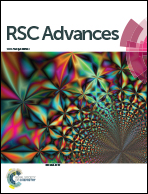C–N cross-coupling reaction catalysed by reusable CuCr2O4 nanoparticles under ligand-free conditions: a highly efficient synthesis of triarylamines
Abstract
A convenient, efficient and ligand-free method for the C–N coupling reaction of anilines and aryl iodides was performed using CuCr2O4 nanoparticles. Copper chromite nanocatalyst improved the rate and facility of the synthesis of triarylamines. The heterogeneous catalyst was fully characterized by scanning electron microscopy, IR and X-ray diffraction techniques. Recyclability, excellent yields of products and short reaction times are the important advantages of this ligand-free procedure by using the CuCr2O4 nanoparticles.


 Please wait while we load your content...
Please wait while we load your content...